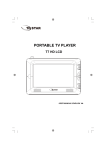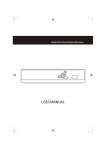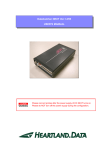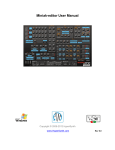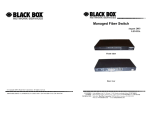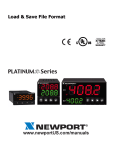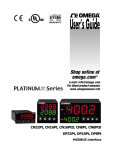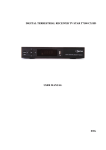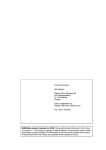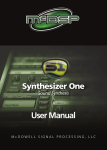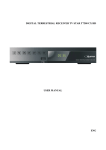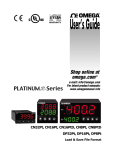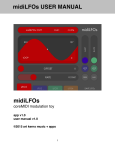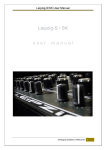Download SIDizer User Manual
Transcript
SIDizer User Manual Copyright © 2006-2011 HyperSynth www.HyperSynth.com rev3.0 SIDizer Manual - - - - - - - - - - - - - - - - - - - - - - - - - - - - - - - - - - - - - - - - - - - - - - - - - - - - - - - - - - - - - - - - - HyperSynth Table of Contents Quick Tips Signal Flow Oscillator 1 Oscillator 2-3 Wavetable Sequencer Filter Bug Generator Bit Cruncher LFO 1&2 Mod Env Modulation Matrix C64 ARP Master MIDI Learn Appendix A - MIDI Implementation Chart Appendix B - MIDI CC Tables 2 SIDizer Manual - - - - - - - - - - - - - - - - - - - - - - - - - - - - - - - - - - - - - - - - - - - - - - - - - - - - - - - - - - - - - - - - - HyperSynth Quick Tips If you press shift key while tweaking a knob, the value will change more precisely. “Double Click” sets the knob position to its default value. Clicking over SIDizer logo shows the about page. Signal Flow OSC 1 Amp Env 1 OSC 2 Amp Env 2 OSC 3 Amp Env 3 Bit Cruncher Spread Reverb Filter Delay Master Volume Oscillator 1 Waveform buttons: determines the waveform of oscillator 1 (saw, sqr, tri, noise) it is possible to select two or three waveforms at the same time here the result will be logical “AND” function of the selected waves that is a unique feature of SID chip. Mode switch: let you enable wavetable sequencer for osc1. D/A Convertor switch: determines the chip D/A convertor type (8580-6581). 6581 convertor adds a little amount of distortion to the signal which is not noticeable in 8580 type. Semi knob: sets the oscillator 1 pitch transpose amount (+/-36 semitones). Fine knob: detunes oscillator 1 freq. PW knob: determines the amount of pulse width for square wave. Level knob: sets oscillator 1 level. Phase sync button: forces oscillator 1 to start at zero phase. (only available for saw, sqr, tri and “saw&tri” waveforms) Sync 1<3 button: synchronizes fundamental frequency of oscillator 1 with frequency of oscillator 3, producing “hard sync” effect. In order for synchronization to occur oscillator 3 must be set to some frequency preferably lower than the frequency of oscillator 1. Ring 1<3 button: When it is selected, it replaces oscillator 1 output with "ring modulated" combination of oscillators 1 and 3. Varying the frequency of oscillator 1 with respect to oscillator 3 produces a wide range of non-harmonic overtone structures for creating bell or gong sounds. In SID chip for enabling “ring mod”, “tri” must be selected as waveform. Here there is no limitation for the selected waveform. Amp Env A knob: sets the amount of attack time (0-8.000s). Amp Env D knob: sets the amount decay time (0-24.000s). Amp Env S knob: sets the amount of sustain level (0-100%). Amp Env R knob: sets the amount of release time (0-24.000s). Acrv: sets the amount of slope for Attack curve which is adjustable from – exp function to linear then to + exp. Dcrv: sets the amount of slope for Decay curve which is adjustable from – exp function to linear then to + exp. 3 SIDizer Manual - - - - - - - - - - - - - - - - - - - - - - - - - - - - - - - - - - - - - - - - - - - - - - - - - - - - - - - - - - - - - - - - - HyperSynth Oscillator 2-3 Oscillator 2 and 3 parameters are the same as oscillator 1, but there are differences: There is no “mode switch” for osc2 and 3 because “wavetable sequencer” is only routed to osc1. Osc2 and 3 have a special amp envelope mode called: “locked to 1” that can be enabled using a switch near the envelope. It lets you route the oscillator pre-env signal to the osc1 amp envelope input. This feature is useful when the same settings are preferred for all envs and it reduces CPU usage slightly. Wavetable Sequencer (WTS) WTS is a tool for achieving extra control over the pitch and waveform of osc1 in order to get more complex sounds. This technique was widely used among C64 fans for creating drum/percussion like sound from the basic waveforms of the SID. (note: Osc2, 3 and waveform buttons of Osc1 are disabled while using WTS.) Mode Switch: sets wavetable repeat behavior (1 cycle, loop). Rate knob: sets interval between the table tracks (0-200.0ms). “R x L”: 1 cycle length in ms. Length knob: sets the number of tracks inthe table (1-8). Transpose knobs: sets the amount of pitch transpose for each track. Waveform buttons: determines the waveform for each track. Loop Point: sets the loop point, “Loop” must be selected as wavetable mode for hearing the function of this parameter. If you set length=5 and loop point=3, the wavetable sequencer will repeat steps like the following pattern : Step1, Step2, “Step3, Step4, Step5”, “Step3, Step4, Step5”, “Step3, Step4, Step5”, … Filter Cut knob: sets the cut-off freq of filter. Res knob: sets the resonance amount. Trk knob: sets the key tracking amount which modulates the filter frequency. For example, it makes filter frequency higher as you play higher notes on the keyboard or lower as you play lower notes. Env knob: determines the depth of filter envelope. Curve switch: determines filter response (Linear, SID-Exp). SID-Exp is an exponential based function which is modeled from a real SID chip freq response. (note that filter response varies between one chip to another so you may find differences in real comparison). Chip model switch: determines the model of SID chip (8580-6581) which slightly alters the character of sound and filter response. Dist knob: sets the amount of filter distortion and also the output level. (only available for 6581) Type buttons: enable selected filter type output. SID chip has a 12dB state variable filter with three outputs (lowpass, hipass, bandpass). Enabling multiple outputs is supported in SID for example LP+HP will get you a Band Reject filter and etc. Bypass buttons: bypass the filter for the selected oscillator so the oscillator signal will feed through master section directly. Filter env-A knob: sets the amount of attack time (0-8.000s). Filter env-D knob: sets the amount of decay time (0-24.000s). Filter env-S knob: sets the amount of sustain level (0-100%). Filter env-R knob: sets the amount of release time (0-24.000s). 4 SIDizer Manual - - - - - - - - - - - - - - - - - - - - - - - - - - - - - - - - - - - - - - - - - - - - - - - - - - - - - - - - - - - - - - - - - HyperSynth Bug Generator Bug Generator is a tool for creating two of the SID chip hardware flaws. (Note that the famous ENV bug is not emulated because no one likes an unwanted random delay at the begging of the notes) External noise knob: sets the amount of External noise level. One of the SID chip flaws is the noise signal which comes from external input of the chip and it is always audible in the background. Oscs leakage knob: sets the amount of oscillators leakage signal. SID amp envelopes do not mute the signal completely even when you send the note-off (gate-off) message to the chip and a noticeable leakage from 3 oscillators is always audible. Note: Setting “External noise” and “Oscs leakage” to zero results in disabling the process and help to reduce cpu usage, otherwise the module always eats cpu because it does not react to note-off message like the other parts of the software. Bit Cruncher Bit cruncher acts like an FX module that you can place it before or after the filter for adding extra lo-fi texture to the sound. Dry/Wet knob: sets the amount of "dry" (unprocessed) signal to be mixed with the "wet" (processed by the effect) signal. Bit depth knob: determines the bit depth for bit cruncher module. Mode selector: determines the input signal routing (pre-filter, post-filter, none). LFO 1&2 An LFO is an oscillator that generates low frequency signals that are used to modulate other parameters of sound. SIDizer LFOs are capable to generate different waveforms (Sin, Saw, Tri, S&H) at the same time which are selectable in Mod Matrix source list. Freq1 knob: sets LFO1 freq (0.001-20.000 Hz). Freq2 knob: sets LFO2 freq (0.001-20.000 Hz). Sync button: synchronizes LFO freq to host tempo. Retrig button: forces LFO signal to start at zero phase. Mod Env The Modulation Envelope is a general purpose envelope, used as Modulation Source in the Modulation Matrix. A knob: sets the amount of attack time (0-8.000s). D knob: sets the amount decay time (0-24.000s). S knob: sets the amount of sustain level (0-100%). R knob: sets the amount of release time (0-24.000s). 5 SIDizer Manual - - - - - - - - - - - - - - - - - - - - - - - - - - - - - - - - - - - - - - - - - - - - - - - - - - - - - - - - - - - - - - - - - HyperSynth Modulation Matrix Modulation Matrix allows you to create user-defined modulation routings. Modulation sources are shown in a column on the left of the display, while the destinations are shown on the right. The modulation amount/depth is displayed in the middle. A negative modulation depth inverts the waveform of the modulation source. Double-clicking on a modulation depth display sets the value to 0.00 (disabled). List of Sources All sources, whether it is MIDI data or synth parameters, are converted to the same range, which is [0,+1] for unipolar and [-1,+1] for bipolar sources: LFO1 Sin, Saw, Tri, Sqr, S/H: Current value of the LFO1 (bipolar). Random U: A random unipolar source. The value of this source is the same if used in several modulation routing. Unipolar means that the source is only increasing (or if applied with negative depth, decreasing) the target’s value. (unipolar). LFO2 Sin, Saw, Tri, Sqr, S/H: Current value of the LFO1 (bipolar). Random B: Similar to Random Unipolar, however a random bipolar source. Bipolar means that the source is randomly increasing or decreasing the target's value (bipolar). MOD ENV: Current value of the Mod-Envelope. The Mod-Envelope is dedicated to be used in the matrix and can be routed to any available modulation destination (unipolar). Filter ENV: Current value of the Filter-Envelope. This envelopes control the Filter cutoff frequency, the envelope can be used as a modulation source (unipolar). Amp ENV1: Current value of the amplitude envelope 1 (unipolar). Amp ENV2: Current value of the amplitude envelope 2 (unipolar). Amp ENV3: Current value of the amplitude envelope 3 (unipolar). Mod wheel: The MIDI modulation wheel data (controller #01). Pitch Wheel: The value of the Pitch-Wheel is taken as modulation source, maybe it makes sense to reduce the Pitch Wheel range to 0 when using the Pitch Wheel as modulation source (bipolar). Note Velocity: The MIDI Note-On velocity information, which is transmitted once at the instant a key is pressed. The harder a key is hit, the higher the modulation value (unipolar). Note Number: The MIDI Note number, using E4 (=64) as the center. Higher keys than the center key transmit positive values, lower keys negative values (bipolar). Aftertouch: The Aftertouch, also sometimes called “Channel Pressure” or “Pressure” value is used as modulation source. Your MIDI keyboard must support this. If this doesn't work it is likely that your keyboard has no aftertouch (unipolar). MIDI Breath: MIDI Breath controller (#02). MIDI Foot: MIDI Foot controller (#04). 6 SIDizer Manual - - - - - - - - - - - - - - - - - - - - - - - - - - - - - - - - - - - - - - - - - - - - - - - - - - - - - - - - - - - - - - - - - HyperSynth MIDI Expression: MIDI Expression controller (#11). Constant: This source simply sends a constant value of 1. This can be useful for a wide range of tasks, for instance to offset a certain parameter. List of Destinations Filter Cut: Adjusts the filter cutoff frequency relative to the front panel knob. It often used with an LFO to create filter sweeps or with Velocity to simulate an acoustic instrument's response to note attack. Filter Level: Used to control the output level of filter. It is better to use “Main Volume” as destination if you want to modulate the amplitude of filtered and unfiltered signal at the same time. Unfiltered signal is routed to output section using OSC bypass switches and it is not modulated with filter level. OSC1/2/3 PitchWide: The tuning of the respective oscillator in semitones (+12 to -12). An amount value of +100% transposes the oscillator one octave up, -100% transposes one octave down. OSC1/2/3 PitchNarrow: The tuning of the respective oscillator in cents. An amount value of +100% transposes the oscillator 150 cent up, -100% transposes 150 cent down. (It is used for creating classic vibrato effect.) OSC1/2/3 PitchExtrem: The tuning of the respective oscillator in semitones (+96 to -96). An amount value of +100% transposes the oscillator 8 octave up, -100% transposes 8 octave down. OSC1/2/3 PW: Pulsewidth of the respective Oscillator waveform. (SQR must be selected as waveform) OSC1/2/3 Level: The amplitude (volume) of the respective Oscillator. In order to create the classic tremolo effect it is better to use “Filter level” or “Main Volume” as the modulation destination as this is applied to the whole voice. LFO1/2 Freq: Changes the rate of the specified LFO relative to the front panel knob. LFO1 Depth: Intensity of LFO1 signal often used with the Mod Wheel as source to control a specific modulation parameter (e.g. Vibrato). Main Volume: Used to control the overall volume of the patch. Modulate this parameter using one of the two LFO’s as a source in order to obtain tremolo effect. Matrix 1-3 Depth: Intensity of the first three entries (1 to 3) in the Modulation Matrix, often used with the ModWheel as source to control a specific modulation parameter. C64 ARP On/Off button: enables or disables the Arp function. Speed knob: sets the Arp speed (0.001-50.000 Hz). Trigger envs button: forces all envelopes to retrig at the beginning of each step. Sync bottun: synchronizes Arp speed to host tempo. Step knob: sets the number of Arp steps (1-8). Note transpose knobs: determines the amount of pitch transpose for each step (+/- 24 semitones). 7 SIDizer Manual - - - - - - - - - - - - - - - - - - - - - - - - - - - - - - - - - - - - - - - - - - - - - - - - - - - - - - - - - - - - - - - - - HyperSynth Master Porta knob: if it is set to a non-zero value will adjust the portamento time and force the synthesizer to function monophonically (voice=1). Voice knob: limits the polyphony of synthesizer. Spread knob: sets the amount of stereo spread effect. Reverb-Width knob: sets the amount of stereo width. Reverb-Damp knob: sets the amount of damping Reverb-Room knob: sets the room size. Reverb-Dry/Wet knob: sets the amount of "dry" (unprocessed) signal to be mixed with the "wet" (processed by the effect) signal. Reverb-OFF/ON switch: enables/disables reverb module. Delay-Time knob: sets the amount of delay time in millisecond. Delay-Sync button: synchronizes delay time to host tempo. Delay-Type selector: determines the delay algorithm (ping-pong delay, cross delay). Delay-Feed knob: sets the amount of feedback for delay. Delay-Dry-Wet knob: sets the amount of "dry" (unprocessed) signal to be mixed with the "wet" (processed by the effect) signal. Delay-On/Off button: enables/disables the delay effect. Volume knob: sets the main output level. Engine Quality Engine Quality selector is located in about window (right click on SIDizer logo). Engine Quality is a global parameter and it is not saved with presets. It has two modes: 1. Host SR: SIDizer engine configures itself to synthesize sounds using maximum power of your PC + sound interface sample rate. 2. C64 CIA: SIDizer engine configures itself to synthesize sounds based on C64 hardware timing for playing chiptunes. It may add more punch and dirt to sound depending on preset. But the setting may also add clip and zippering so it must be used with care. MIDI Learn SIDizer lets you remotely control most parameters using Midi Continuous Controller Data (Midi CC). In addition to the messages specified in the MIDI Implementation Chart, the following MIDI CC messages in “MIDI CC Tables“ are recognized and affect their associated parameters. By sending MIDI CC messages, you can change these parameters at any time from your host. You can override the default mapping as listed in “MIDI CC Tables“ on demand by learning the controls to different CCs. MIDI learn can be accessed by right clicking over the knobs or buttons : Learn a control on SIDizer to an external controller: 1. Right Click on a knob and select MIDI Learn. 2. Move the controller on your controller device which you want to learn to it. If you want to disable the current or default mapping you should right click on the knob and select midi forget. 8 SIDizer Manual - - - - - - - - - - - - - - - - - - - - - - - - - - - - - - - - - - - - - - - - - - - - - - - - - - - - - - - - - - - - - - - - - HyperSynth Appendix A MIDI Implementation Chart Function Txd Rxd Default Changed Default Changed Sound range x x x x x 1-16 1-16 Mode 1 x 0-127 Note On Note Off Keys Channels Pitchbend x x x x x o x x o o Control Change x o x o System Exclusive x x NRPNs x x RPNs x x x x x x x x x x x x x x x x x o x x Basic Channel Mode Note number Velocity Aftertouch Program Change System Common System Real Time Aux Messages Actual No. Song Position Song Select Tune Request Clock Commands Local On/Off All Notes Off Act. Sensing Reset Remarks Messages are always received on all channels OMNI Mode is always on Txd = Transmits MIDI message Rxd = Receives MIDI message o = implemented x = not supported Appendix B MIDI CC Tables Parameter OSC1-Waveform saw OSC1-Waveform sqr OSC1-Waveform tri OSC1-Waveform noise OSC1-Envelope Attack OSC1-Envelope Decay CC# 3 9 10 12 73 13 Parameter Filter-Resonance 6581 Filter-Enevelope Depth Filter-Envelope Attack Filter-Envelope Decay Filter-Envelope Release Filter-Envelope Sustain CC# 45 46 47 48 49 50 9 SIDizer Manual - - - - - - - - - - - - - - - - - - - - - - - - - - - - - - - - - - - - - - - - - - - - - - - - - - - - - - - - - - - - - - - - - HyperSynth Parameter OSC1-Envelope Release OSC1-Envelope Sustain OSC1-PW OSC1-Fine OSC1-Level OSC1-Semitone OSC2-Waveform saw OSC2-Waveform sqr OSC2-Waveform tri OSC2-Waveform noise OSC2-Envelope Attack OSC2-Envelope Decay OSC2-Envelope Release OSC2-Envelope Sustain OSC2-PW OSC2-Fine OSC2-Level OSC2-Semitone OSC3-Waveform saw OSC3-Waveform sqr OSC3-Waveform tri OSC3-Waveform noise OSC3-Envelope Attack OSC3-Envelope Decay OSC3-Envelope Release OSC3-Envelope Sustain OSC3-PW OSC3-Fine OSC3-Level OSC3-Semitone Filter-Cut Filter-Resonance 8580 CC# 72 14 15 16 17 18 19 20 21 22 23 24 25 26 27 28 29 30 31 33 34 35 36 37 39 40 41 42 43 44 74 45 Parameter Filter-Key track Filter-LP enable Filter-HP enable Filter-BP enable Filter-OSC1 bypass Filter-OSC2 bypass Filter-OSC3 bypass Filter-Distortion LFO-Freq 1 LFO-Freq 2 Master-Volume Master-Mod wheel Master-Spread Master-Porta Master-Delay Dry-wet Master-Delay feed Master-Delay time Master-Reverb Dry-Wet Master-Reverb width Master-Reverb room Master-Reverb damp Mod Envelope-Attack Mod Envelope-Decay Mod Envelope-Release Mod Envelope-Sustain Bug Gen-Oscs leakage Bug Gen-External noise Bit Cruncher-Bit Bit Cruncher-Dry/Wet WaveTable-Rate WaveTable-Length WaveTable-Loop Point CC# 51 52 53 54 55 56 57 58 59 60 7 1 8 5 61 62 63 91 65 66 67 68 69 70 71 75 76 77 78 79 80 81 Support info: If you encounter any problems, or you have suggestions for future revisions, don’t hesitate to contact our technical support at: [email protected] Copyright © 2006-2011 HyperSynth www.HyperSynth.com 10










